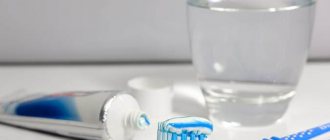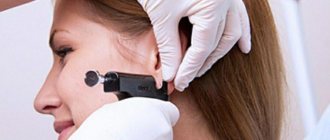Diagnosing the problem at home
Sometimes, to understand which tooth hurts, it is enough to look into your mouth. You need to go to the mirror and conduct a visual inspection. The diseased element may be damaged, with dark spots and depressions. There are also signs that indicate a problem: chipped, worn, cracked or transparent enamel, the presence of pustules and seals on the mucous membrane, inflamed, swollen or bleeding gums.
It also happens that a visual inspection reveals nothing. For example, when the problem develops under an artificial crown or filling. In this case, light pressure on the crowns or gently tapping them with the tip of a teaspoon will help determine the source of the pain.
How else can you find out which tooth hurts? During eating, pieces of food can become lodged in an element destroyed by dental diseases; it is difficult not to feel it. Hard tissues in the area of the pathological process can react to food temperature and mechanical stress during hygiene procedures.
On a note! If you want to understand which tooth hurts, then take the diagnostic question seriously. Before examination, remove soft plaque and food debris from your mouth. The room where the inspection is being carried out should have good lighting. Carefully examine every visible surface of the tooth using a mirror, and also check your gums for inflammation.
Causes of toothache
As we have already said, the main reason for such painful sensations is the thinning of the enamel. Hyperesthesia can also develop due to:
- dentin reactions;
- allergies to dental medications;
- periodontal diseases;
- mechanical damage to enamel;
- hereditary predisposition.
Let's look at each cause of the problem in more detail.
We determine the cause of pain by the nature of the sensations and accompanying symptoms
In most cases, checking which tooth hurts on your own is not difficult. It is more difficult to establish why the discomfort and discomfort appeared. It all depends on the accompanying symptoms.
| Possible reason | Associated symptoms |
| Increased sensitivity of enamel | Thin, transparent enamel, with cracks and chips. Reaction to cold and hot, sour, sweet. Discomfort due to mechanical impact. Often pain occurs not in one, but in several teeth at once or along an entire row |
| Caries | Reaction to food temperature and mechanical stress. The discomfort goes away almost immediately after the irritating factor is eliminated, but as the disease progresses, the pain persists longer. First, white chalky spots appear on the enamel, then black dots, depressions and pits into which food easily gets clogged. |
| Pulpitis | The pain is acute and prolonged, persists for a long time after the removal of the stimulus, can occur involuntarily, and “spread” to all parts of the face and head. Unpleasant sensations intensify at night. With pulpitis, the enamel of the diseased tooth may darken |
| Periodontitis | May occur under a filling or crown. Sharp pain appears when pressing or chewing solid food. With this disease, there is a feeling of fullness and pressure in the inflamed area. The root of the diseased unit may begin to wobble |
| Flux, abscess, cyst | The gums around the diseased element become inflamed, and ulcers, pimples, and lumps may appear on the mucous membrane. In acute and advanced stages, swelling of the soft tissues of the face occurs. Unpleasant sensations intensify during tapping and pressure on the sore area |
| Fistula | An ulcer or pimple on the gum that may ooze fluid or pus. Unpleasant taste and odor in the mouth |
| Root fracture, crack, trauma | Sharp and acute pain, the tooth becomes mobile, it is impossible to chew food on it |
| Periodontal inflammation | If it is not clear which tooth hurts, then it may not be about the tooth at all, but about the periodontal tissues. So, with gingivitis or periodontitis, the mucous membrane itches and becomes inflamed, and also bleeds, and this process is most often generalized (applies to the entire jaw). At advanced stages of periodontitis, the roots become exposed and the teeth become mobile and begin to respond to thermal and mechanical stress. |
| Previously performed poor-quality treatment | If you just recently visited the dentist, and after that the treated tooth began to ache, then in the first 2-4 days this situation can be considered normal. In most cases, this indicates a tissue reaction to various medications and surgical intervention. With each subsequent day, the discomfort should decrease, but if it becomes stronger, this may indicate medical errors made during treatment. |
“I don’t advise anyone to guess on the coffee grounds and independently identify various diseases. In general, I never know which tooth hurts me, because the sensations are always ambiguous. The other day, there was a situation: my upper jaw was aching, and I was sure that the problem was there, although visually everything was normal everywhere. Even when I went to the doctor, I indicated a specific area, but the dentist looked and said that this was not so. As a result, the lower filled molar turned out to be problematic, under which secondary caries developed, and it was treated.”
Katerina, review from the dental portal gidpozubam.ru
How does this pathology manifest itself?
Acute periodontitis is characterized by:
- sharp pain when biting on a tooth;
- feeling as if it has shifted;
- swelling of the soft tissues of the gums;
- increase in body temperature.
In the chronic form of dental periodontitis, the following symptoms are characteristic:
- wave-like appearance and disappearance of pain;
- increased tooth sensitivity when biting;
- periodic formation of a fistulous tract in the gum tissue with the appearance of purulent discharge.
The whole jaw aches: what does this mean?
Many patients, when visiting a doctor, complain that their entire jaw ache, but after examination it turns out that one tooth is to blame. Why is this happening? With some pathologies, pain can radiate (give) to different parts of the face and head: jaw, temple, ear, eyes. This often happens with pulpitis, eruption of wisdom teeth, the presence of impacted and dystopic elements in the jawbone that grow in the wrong direction, put pressure on their neighbors or do not break out at all. Pain can radiate to different areas if the disease is in an acute stage or the patient has advanced pathology.
On a note! Does your entire jaw ache after tooth extraction? This situation is also not uncommon, especially if the extraction was difficult and traumatic, or occurred against the background of a cyst or abscess. To ensure that the discomfort quickly disappears, strictly follow all the doctor’s recommendations. If improvements do not occur after 5-7 days, and alarming signs intensify, then contact your dentist immediately.
The entire jaw may ache if the patient has a malocclusion, since against the background of this problem the maxillofacial apparatus or its individual areas are overloaded, and teeth wear out, wear out and are destroyed ahead of schedule. Discomfortable sensations radiating throughout the entire jaw can also occur during bite correction with orthodontic devices, but many patients admit that these are temporary difficulties, because after a period of adaptation to braces or trainers, the situation normalizes.
If teeth have nothing to do with it
Sometimes it is not clear which tooth hurts. It may even seem like everything hurts at once. But dental disease is not always the cause. Similar symptoms may indicate other problems:
- inflammation of the trigeminal nerve,
- cancerous tumors in the oral cavity,
- ENT diseases: sinusitis, sinusitis, otitis media,
- hypothermia,
- salivary stone disease,
- dysfunction of the temporal mandibular joint,
- pathologies of the cardiovascular system: for example, angina pectoris,
- intervertebral hernia, pinched cervical nerve,
- psychosomatic state of a person: it may simply seem to you that your teeth are aching, especially if you have recently suffered stress,
- Jaw Fracture: Discomfort may occur even years after you have been treated. Some people note that in this way the body and the bones that have grown together after injury react to changing weather.
It is important to understand that internal diseases of the body can aggravate dental problems or contribute to their occurrence, just as, conversely, diseased teeth can cause other pathologies, such as sinusitis. This occurs due to the fact that infections from the source of inflammation can freely penetrate into all adjacent areas.
Clinical researches
Repeated clinical studies have proven that the two-component mouth rinse ASEPTA ACTIVE more effectively combats the causes of inflammation and bleeding compared to single-component rinses - it reduces inflammation by 41% and reduces bleeding gums by 43%.
Sources:
- The effectiveness of the use of Asept “adhesive balm” and Asept “gel with propolis” in the treatment of chronic generalized periodontitis and gingivitis in the acute stage (Municipal Dental Clinic No. 4, Bryansk, Kaminskaya T. M. Head of the therapeutic department Kaminskaya Tatyana Mikhailovna MUZ City Dental Clinic No. 4, Bryansk
- Study of the clinical effectiveness of treatment and prophylactic agents of the Asepta line in the treatment of inflammatory periodontal diseases (A.I. Grudyanov, I.Yu. Aleksandrovskaya, V.Yu. Korzunina) A.I. GRUDYANOV, Doctor of Medical Sciences, Prof., Head of Department I.Yu. ALEXANDROVSKAYA, Ph.D. V.Yu. KORZUNINA, asp. Department of Periodontology, Central Research Institute of Dentistry and Maxillofacial Surgery, Rosmedtekhnologii, Moscow
- The role of anti-inflammatory rinse in the treatment of periodontal diseases (L.Yu. Orekhova, A.A. Leontyev, S.B. Ulitovsky) L.Yu. OREKHOVA, Doctor of Medical Sciences, Prof., Head of Department; A.A. LEONTIEV, dentist; S.B. ULITOVSKY, Doctor of Medical Sciences, Prof. Department of Therapeutic Dentistry of St. Petersburg State Medical University named after. acad. I. P. Pavlova
- Report on the determination/confirmation of the preventive properties of personal oral hygiene products “ASEPTA PLUS” Remineralization doctor-researcher A.A. Leontyev, head Department of Preventive Dentistry, Doctor of Medical Sciences, Professor S.B. Ulitovsky First St. Petersburg State Medical University named after. acad. I.P. Pavlova, Department of Preventive Dentistry
Methods for diagnosing problems in dentistry
Regardless of whether it is clear or unclear to you which tooth hurts, the first thing to do when an alarming symptom occurs is, of course, to consult a doctor. The specialist will not only accurately diagnose, but also cure the disease that caused the problem. Otherwise, after a short period of time you will notice that not just one, but several nearby units are aching, as the infection has spread further.
Today in dentistry there are many diagnostic methods, one of the informative ones is x-ray examination. To determine the condition of the entire jaw system, roots, root canals and bone tissue, as well as to identify hidden problems, for example, fractures and cracks of the root, cysts and granulomas, the presence of dystopic and impacted teeth, doctors prescribe a two-dimensional panoramic image of the jaw or CT (computed tomography) . The second type of examination - computed tomography - is more accurate, as it allows you to obtain three-dimensional 3D images and examine all processes in great detail.
In addition to X-rays, the doctor will definitely conduct a visual examination using a mirror, percussion1 (tapping on the crown) and examination of the oral cavity using special instruments (dental probe). Additionally, electroodontodiagnosis may be prescribed to determine the viability of the pulp, color and thermal tests to identify various non-carious (hypoplasia, wedge-shaped defect) and carious pathologies.
Why does inflammation develop?
The main reason for the development of inflammatory processes in the pulp is infection due to advanced caries. Usually (in 90% of cases) the infection enters the pulp through a carious cavity. But sometimes a retrograde route is possible (the penetration of bacteria through a hole in the root or periodontal pockets). It is extremely rare (with osteomyelitis, acute respiratory infections, rubella, chickenpox, sinusitis) the infection is introduced through the blood - the hematogenous route.
Other factors can cause pulpitis:
- poor-quality treatment of a carious cavity or accidental damage to the pulp chamber during the treatment of caries;
- improper filling of the canal;
- pulp burn when grinding a dental crown before prosthetics;
- gum diseases leading to the formation of periodontal pockets;
- tooth injury.
Depending on the etiology, there are 4 types of pulpitis:
- infectious
– develops due to the penetration of pathogenic bacteria into the pulp;
- traumatic
– the cause is a violation of the sterility of the pulp due to traumatic damage to the tooth, due to which opportunistic bacteria are directed into the pulp chamber and provoke inflammation;
- iatrogenic, or medical
– occurs due to the fault of the dentist due to improper treatment of the carious cavity;
- calculiform
– the result of a metabolic disorder in the neurovascular bundle, accompanied by the formation of stones or denticles (replacement dentin).











